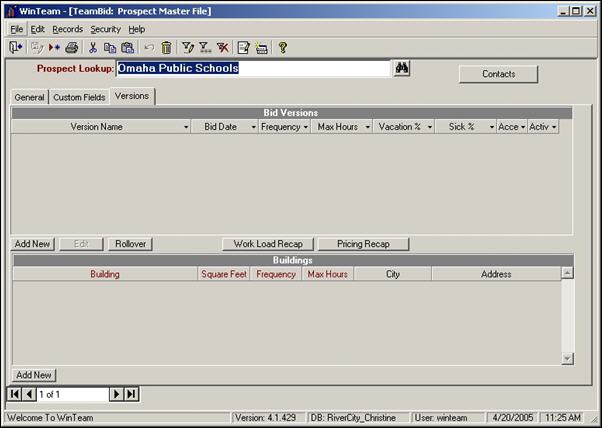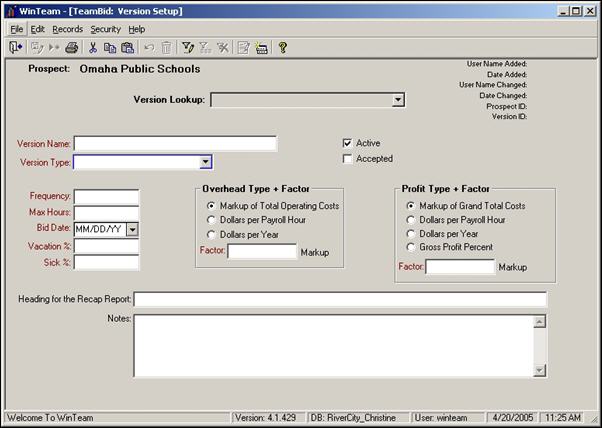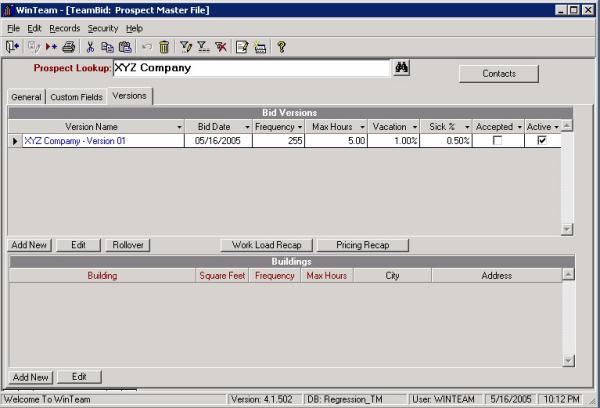The Version Setup screen is primarily opened from the Prospect Master File (Versions tab). You can add one or multiple Versions of bids for a Prospect.
Once a Prospect Master File record has been added, the system automatically creates the first Building record for the Prospect. In order to view or edit the Building record, you must add a Version to the Prospect.
Each Version can have multiple Buildings as part of the bid and each Building contains a set of Areas. A Building can be used multiple times under different Versions.
To add a Version to a Prospect
From the Prospect Master File, click the Versions tab. The Bid Versions grid is read-only, however, the Add New button opens the Version Setup screen for adding a new Version.
Click Add New in the Bid Versions grid to open the Version Setup screen.
Enter a Version Name. Use a description that applies to this bid.
Type or select a Version Type. Version Types are used to group similar type Versions for filtering, sorting and reports. To add a new Version Type, double-click in the Version Type field, or type a new Version Type Description and press Enter. The Version Types add/edit list displays.
Enter the number of days per year the Building will be serviced in the Frequency field. The Frequency entered here will carry over to the Buildings grid. It is also used to calculate the average daily work hours for Work Loads.
Enter the Max Hours to budget for this Building. This value represents only the number of hours the property is available for service. In other words, this is the window of time the prospect is going to allow you to service the building in a 24 hour period. This figure will then be used to calculate the number of people needed to clean this building in the maximum allotted time.
Enter a Bid Date. This could be the date the bid is due or could be the date the bid was created.
If a Vacation % was entered in TeamBid Defaults, it displays here. You may modify it. The Vacation % is the percentage of total payroll to budget for vacation time. This percentage is multiplied by the Total Labor Cost and then included in Total Labor amount.
If a Sick % was entered in TeamBid Defaults, it displays here. You may modify it. The Sick % is the percentage of total payroll to budget for sick time. This percentage is multiplied by the Total Labor Cost and then included in the Total Labor amount.
If the Overhead Type + Factor was entered in TeamBid Defaults, it displays here. You may modify it. The Overhead Type is used to define how the system will calculate overhead. There are 3 options:
Markup of Total Operating Costs - Using this option requires that the Factor includes a percentage for Markup. Total Operating Costs X % Markup = Overhead
Dollars per Payroll Hour - Using this option requires that the Factor includes an amount per payroll hour. This would normally be entered in cents ($0.21 per payroll hour). Total Labor Hours X amount per hour = Overhead
Dollars per Year - Using this option requires that the Factor include a whole dollar amount. Amount per year = Overhead The calculated result displays on the Pricing Recap screen.
If the Profit Type + Factor was entered in TeamBid Defaults, it displays here. You may modify it. The Profit Type is used to define how the system will calculate profit. There are 4 options:
Markup of Grand Total Costs - Using this option requires that the Factor includes a percentage for Markup.Grand Total Cost + % Markup = Profit Amount $100 + 20% (100 X 20%) = $120 Selling Price
Dollars per Payroll Hour - Using this option requires that the Factor includes an amount per payroll hour. This would normally be entered in cents ($0.21 per payroll hour).
Dollars per Year - Using this option requires that the Factor includes a whole dollar amount.
Gross Profit Percent - Using this option requires that the Factor includes a percentage of profit. Grand Total Cost x Percent Profit / 1 - Percent Profit = Profit amount $100 x 20% / 1 - 20% = Profit amount $20 / .8 = Profit Amount $25 = Profit Amount 25 / 125 equals the 20% profit from Grand Total Cost
The calculated result displays on the Pricing Recap screen.
Click Close to return to the Prospect Master File (Versions tab).
The Version is now part of the Prospect Master File record. Now we may set up one or more Buildings.
To set up Buildings, see Setting Up Buildings.
